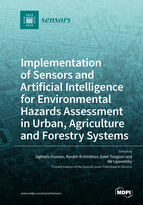Implementation of Sensors and Artificial Intelligence for Environmental Hazards Assessment in Urban, Agriculture and Forestry Systems
A special issue of Sensors (ISSN 1424-8220). This special issue belongs to the section "Remote Sensors".
Deadline for manuscript submissions: closed (20 March 2021) | Viewed by 51522
Special Issue Editors
Interests: digital agriculture; food and wine sciences; plant physiology; remote sensing; climate change; robotics applied to agriculture and computer programming
Special Issues, Collections and Topics in MDPI journals
Interests: sensor engineering; spanning image and spectral sensors; machine learning on sensors; augmented reality (AR) displays; sensors for space; drone-based sensor applications; electronic sensors for biomedical applications; new thermal spectral cameras and nanophotonic engineering
Special Issues, Collections and Topics in MDPI journals
Interests: plant physiology; crop molecular genetics and biotechnology; computer vision; short-range remote sensing
Special Issue Information
Dear Colleagues,
Forecasted climate change scenarios are projecting an increase in climatic anomalies’ occurrence, severity, and intensity. Evidence of such anomalies has been reported worldwide, such as extreme heat waves, bushfires, severe frosts, dust storms, hailstorms, and catastrophic events, such as hurricanes, and heavy rains as part of monsoons or El Nino–Southern Oscillation (ENSO). These events have a direct impact on agricultural systems, urban green infrastructures, and forestry, which may be difficult to monitor due to large extensions, and complexity of the physiological and morphological architecture of subjects (i.e., plants, trees, animals). Therefore, implementation of new and emerging technologies could be an important tool to assess the effects of these environmental risks on important aspects of health and productivity that are relevant for the different areas mentioned. This Special Issue call is mainly focused on the integration of different sensors, remote sensing, and sensor network technologies with powerful data analysis techniques, such as machine learning and artificial intelligence. Priority will be given to those papers that integrate more than one new and emerging technology with AI analysis, interpretation, and decision-making systems to produce practical tools for growers, practitioners, urban planners, and the public in general. The latter is in the form of robust AI models, computer algorithms, applications, and software coupled with integrated hardware systems and connectivity (IoT).
The environmental hazards to be considered in this Special Issue call include but are not limited to:
- Heat waves;
- Hailstorms;
- Frost events;
- Bushfire events (fire and smoke);
- Extreme rains;
- Environmental pollution;
- Dust pollution;
- Contaminants (air, water, chemical).
The systems to be considered are:
- Agricultural crops (broadacre, horticultural, glasshouse);
- Animal production (effects on productivity, welfare and physiology);
- Urban green infrastructure;
- Forestry systems (natural and productive).
The sensors to be considered, but not limited to:
- Electrical and optical sensors;
- Infrared sensors;
- Image sensors;
- Gas sensors;
- Radar;
- Lidar;
- Multispectral sensors;
- General sensors (temperature, flow, moisture, humidity, pressure);
- Ultrasonic sensors.
Assoc. Prof. Sigfredo Fuentes
Dr. Ranjith R Unnithan
Dr. Eden Tongson
Dr. Nir Lipovetzky
Guest Editors
Manuscript Submission Information
Manuscripts should be submitted online at www.mdpi.com by registering and logging in to this website. Once you are registered, click here to go to the submission form. Manuscripts can be submitted until the deadline. All submissions that pass pre-check are peer-reviewed. Accepted papers will be published continuously in the journal (as soon as accepted) and will be listed together on the special issue website. Research articles, review articles as well as short communications are invited. For planned papers, a title and short abstract (about 100 words) can be sent to the Editorial Office for announcement on this website.
Submitted manuscripts should not have been published previously, nor be under consideration for publication elsewhere (except conference proceedings papers). All manuscripts are thoroughly refereed through a single-blind peer-review process. A guide for authors and other relevant information for submission of manuscripts is available on the Instructions for Authors page. Sensors is an international peer-reviewed open access semimonthly journal published by MDPI.
Please visit the Instructions for Authors page before submitting a manuscript. The Article Processing Charge (APC) for publication in this open access journal is 2600 CHF (Swiss Francs). Submitted papers should be well formatted and use good English. Authors may use MDPI's English editing service prior to publication or during author revisions.
Keywords
- environmental risks
- artificial intelligence
- remote sensing
- sensor networks
- Internet of Things
- integrated sensors
- computer vision










